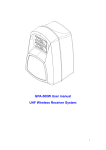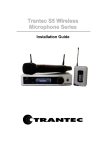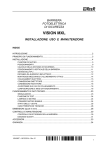Download Audio Authority HCX-11 Installation guide
Transcript
Trantec S5 Wireless Microphone Series Installation Guide 1 of 34 Contents 3. Introduction, System Overview 4, 5. Safety - Important Instructions 6 - 7. Getting Started, Receiver Set-Up 8 - 11. Receiver Frequency Selection 12 - 15. Miscellaneous Settings 16, 17. Handheld Transmitter Set-Up 18, 19. Beltpack Transmitter Set-Up 20. Operating Hints 21. Troubleshooting Guide 22. S5 System Accessories 23, 24. S5 System Part Numbers 25, 26. Rack Mount Kit 27. Multi-Channel Configuration with ADU 28. Antenna Head Amplifiers 29, 30. Mini-XLR Wiring Connections 31, 32. Technical Specifications 33. Warranty 34. CE Declaration of Conformity, WEEE Statement 2 of 34 Introduction The Trantec S5 series represents our commitment to our customers by providing high-quality, reliable Wireless audio links using our considerable design expertise gained over many years as a leading edge manufacturer. We would like to thank you for purchasing this product and would like you to study this guide, especially the safety instructions before installing and using this equipment. S5 Series System Overview The S5 series is a professional UHF wireless microphone system with features including: • • • • • • • • • • • • • 24 channel simultaneous operation (S5.3 12 channel) 10 preset banks including 1 custom user (S5.3 9 Banks) True “dual receiver” diversity – to minimise drop-outs Intuitive LCD and operating system on both receiver and transmitter Infra-red programming for fast system set-up Software transmitter function locks Headphone monitoring as standard XLR (switchable mic and line) and ¼ “jack AF outputs AF processing menu (S5.5 only) Over 1400 customer selectable channels Fully integrated PC software monitoring facility via USB port All metal construction of receiver and transmitters Rack kit and front mounting antenna adaptors included (S5.5 only) 3 of 34 Safety Our aim is to supply you with a product that provides you with countless hours of trouble-free use. In order to achieve this goal we recommend the following: • • • • • • • • • • • • Keep the system away from direct sources of heat, e.g. Central heating radiators, heaters and direct sunlight. Do not expose the unit to an environment where it could be splashed with liquids as this may result in fire or electric shocks. Should the transmitters remain unused for an extended period of time we recommend that the batteries are removed to avoid any potential leakage. Keep the system clean by using a slightly damp cloth. Never use household cleaning agents or solvents. Avoid using or storing the system in damp conditions. Always use the AC power adaptor supplied with the receiver and always disconnect from the AC outlet when not in use. Never remove the external covers of the equipment, exposing the electronics, or modify the unit in any way. Do not handle the mains lead with wet hands Never pull the cord of the AC adaptor, always grasp the main body of the unit when connecting/disconnecting to an AC power outlet. Route the AC power lead in such a way that it is not likely to be stepped on or tripped over. Do not use if the AC power lead becomes damaged. A damaged AC lead may cause fire or give you an electric shock. Never touch any part of the system during a thunderstorm as this may result in severe electric shock. Dispose of batteries responsibly. Do not break open or incinerate, and do not place in household waste. Consult your local waste authority for advice on disposal. Should the covers be removed or there is any other breach of the above instructions, the warranty becomes null and void, in addition to personal risk from burns and/or electric shock. If any of the following conditions occur when using the unit, switch off and remove the AC adaptor from the AC outlet immediately and contact your nearest dealer. • • • Smoke or unusual smell Water or foreign metallic object inside unit Physically damaged housings 4 of 34 5 of 34 Getting Started The S5 series is a high quality, fully featured wireless microphone system with many features, including an intuitive operating system. To enable you to get started we recommend you initially set up the system as outlined in the next few pages. Receiver Set-Up 6 of 34 1. Attach the 2 supplied antennae to the rear panel TNC antenna connectors as shown left. 2. Connect the AC/DC adaptor into the DC inlet as marked on the rear panel, feeding the cable through the attached strain relief. Observe that the front panel on-off switch surround is illuminated red. 3. Connect the rear panel audio output from either the ¼” jack or XLR to your mixing console or amplifier. Note: the XLR balanced output can be switched for either mic or line. The system can be also monitored from the headphone socket, using the “Jog-Wheel” to adjust the volume level. 4. Switch the On/Off switch to the “On” position. The switch surround will now be illuminated green and the receiver will default to its initial setting (BK1.01). The system is now ready for use. 7 of 34 Receiver Frequency Selection Frequency Selection Options 1. To change the selected channel in BANK1 Press and hold the “Jog-wheel” for approximately 3 seconds if the receiver is not in mute to enter the MAIN MENU. You will enter the MAIN MENU immediately if the receiver is in mute. With FREQ SELECT underlined press the “Jog Wheel”. Rotate the “Jog Wheel” till BANK is underlined and press. Press to select BANK1. Rotate the “Jog-wheel” to change the channel. Finally, press to select the new frequency. (See the attached frequency table). 8 of 34 2. To change the selected Bank Press and hold the “Jog-wheel” for approximately 3 seconds if the receiver is not in `34as to enter the MAIN MENU. You will enter the MAIN MENU immediately if the receiver is in mute. With FREQ SELECT underlined press the “Jog Wheel”. This will give you the next menu. Rotate the “Jog Wheel” until BANK is underlined and press to give you the Bank selection screen below right. Rotate the “Jog Wheel” to underline a new bank, then press to select. Press to select the frequency shown or rotate to change to another frequency within this bank. Press again with ACCEPT underlined to accept the new bank. (See the attached frequency table). Go to step 4 to program the transmitter via the receiver infra-red port. 9 of 34 3. To change the selected channel to a Custom single frequency This option allows the customer to select 1 of over 1400 available channels. Press and hold the “Jog-wheel” for approximately 3 seconds if the receiver is not in mute to enter the MAIN MENU. You will enter the MAIN MENU immediately if the receiver is in mute. With FREQ SELECT underlined, press the “Jog-wheel”. With SINGLE underlined press the “Jog-wheel”. With EDIT underlined press the “Jogwheel”. The first part of the frequency will be flashing. Rotate the “JogWheel” to select this section of a new frequency and press to accept. The second part of the frequency will now start flashing. Change the second part of the new frequency as above. You can then change each letter of the user name in the same way. All ASCII characters are available for the user name. If you wish to exit this menu at any time, press and hold the “Jog-Wheel”. Press the “Jog-Wheel” for 1 second to exit then rotate till ACCEPT is underlined and press to select the new custom frequency and user name. Go to the next step to program a transmitter via the receiver infra-red port. Please note: For S5.3 product the single user frequency will be added to the transmitter with receiver Bank1. The S5.3 does not have USER bank. In the case of the S5.5 it will be added to the Custom USER bank. You can download USER banks via the Trantec software. Please refer to the software manual on this CD for more information. Units for the Japanese market do not have USER or SINGLE options in the FREQUENCY SELECT menu. 10 of 34 4. Program a transmitter with Bank information via receiver Infra-red port Press and hold the “Jog-wheel” for approximately 3 seconds if the receiver is not in mute to enter the MAIN MENU. You will enter the MAIN MENU immediately if the receiver is in mute. Rotate the “Jog Wheel” till TX SET is underlined and press to enter TX SETTINGS. With FREQUENCY underlined, press the “Jog Wheel”. Align the transmitter and receiver infra-red windows with the transmitter no more than 15 cm from the receiver. With SEND underlined, press the “Jog Wheel” and wait a few seconds. All frequencies in the bank selected will be transferred to the transmitter and its current frequency will be set to match the receiver’s current frequency. The receiver will return to its main display. For S5.5 - If the receiver is currently in a SINGLE or USER frequency, it will transfer the USER bank. For Japanese units - only fixed banks 1 to 6 are available. For S5.3 - If the receiver is currently in a SINGLE frequency, it will transfer Bank1. 11 of 34 Miscellaneous Settings RX Settings Mute/Squelch Settings The S5 series uses sophisticated internal mute functions including Pilot Tone, Noise and RSSI to prevent noise break through from external sources when the transmitter is in the “OFF” position. The RSSI (Received signal strength) portion is user adjustable via the RX SETTINGS MENU. To Access this press the “Jog-Wheel” for 1 second and enter the MAIN MENU, or for 3 seconds if not in mute. Rotate till RX SET is underlined and press. With MUTE underlined, press the “Jog-Wheel”. Now rotate the “JogWheel” to adjust the mute setting between 1 and 10, then press. A marker shows the current mute setting in relation to the RF A and B scales. Please note: high mute settings will decrease range and low mute settings increase the interference potential. We recommend a setting of 4 to 6. The mute level changes in real time as the setting is varied. Audio Processing (S5.5 only) Press the “Jog-Wheel” to enter the MAIN MENU. Rotate till RX SET is underlined then press. On the RX SETTINGS menu, rotate till AUDIO is underlined and press. Options available here are PHASE REV, LoCUT, and HiBOOST. The default factory setting for all these options is OFF. Navigate to each option by rotating the “Jog-Wheel” and press to check the box for each option when it is underlined. PHASE REV – reverses the audio output phase. LoCUT – reduces the low frequency response. HiBOOST – increases the high frequency response. 12 of 34 All three of the above functions change in real time as the option is selected. Rotate the “Jog-Wheel” to underline EXIT after making your selections, and press to return to the main screen. Headphone Volume Rotate the “Jog-Wheel” while the main screen is showing to go to the headphone volume adjustment. A bar graph of the volume is shown and can be altered by again turning the “Jog-Wheel”. Push to exit and return to the main screen. The unit will return to the main screen automatically if there is no user intervention for approximately 2 seconds. Any change you have made will be saved. Scanning The scanning feature can determine which frequencies are currently being used in the vicinity of your receiver. From the main screen press the “JogWheel” to go to MAIN MENU, rotate till FREQ SEL, is underlined and push. Then rotate till SCAN is underlined and push. The scanning process takes about 10 seconds and you will then be shown the Bank selection screen. If interference is found on a frequency during the scan, the bank containing that frequency is made unavailable on the receiver. You can then select any bank from those available, and any frequencies from within those banks. 13 of 34 Pilot Tone The S5 series has the ability to disable the pilot tone as a means of either identifying outside interference or allowing compatibility with non-pilot tone devices. The default factory setting is ON. To disable Pilot Tone press the “JogWheel” to go to MAIN MENU. Rotate till RX SET is underlined and push to go to the RX SETTINGS menu. Rotate the “Jog-Wheel” to underline PILOT and press to uncheck the box. Rotate the “Jog-Wheel” to exit this screen, and press to return to the main screen. Phantom Power DC added to the antenna inputs for powering head amplifiers. The default factory setting is OFF. Push the “JogWheel” to show the MAIN MENU. Rotate the “Jog-Wheel” to underline RX SETTINGS, and push to show the next menu. Rotate to underline PHANTOM, and push. Press to check the PHANTOM PWR box. Rotate and then press to choose EXIT and return to the main screen. LCD Contrast Push the “Jog-Wheel” to bring up the MAIN MENU. Rotate the “Jog-Wheel” to underline RX SETTINGS. Rotate to underline LCD and push, then rotate the “Jog-Wheel” to alter the LCD CONTRAST. Push to exit and return to the main screen. The unit will return to the main screen automatically if there is no user intervention for approximately 2 seconds. Any change you have made will be saved. 14 of 34 TX Settings Lock TX Switch To prevent unauthorised or accidental changes of frequency or gain on a transmitter, or accidentally turning a transmitter off during a performance you can lock these features from the receiver. Press the “Jog-Wheel” to show the MAIN MENU. Rotate the “Jog-Wheel” to underline TX SET and push to select this option. Rotate the “Jog-Wheel” till LOCK is underlined and push to select this. Push the “Jog-Wheel” to check the box for POWER if required, or rotate to go to FREQ/GAIN and push to check this box if required. Rotate till EXIT is underlined and push. You will then have the option to SEND the TX Locks you have selected, to a transmitter or CANCEL. If you are sending Locks to a transmitter you should hold it within 15cm of the receiver and with the infra-red windows of each aligned. 15 of 34 Handheld Transmitter Set-Up 1. Opening The Microphone Undo the handheld sleeve by unscrewing the end cap at the base anticlockwise and then gently sliding the sleeve down to expose the LCD and Battery compartment. 2. Battery Fitting Place an Alkaline “AA” cell into the battery compartment noting the correct polarity as shown on the label in the compartment. 3. Switch On Slide the On/Off switch to the “On” position and observe the display is on and the Power On LED located in the end cap is illuminated. 4. Check For Received Signal Check that the display indicates the same channel as the receiver. The receiver should now show a received signal on its RF bar graphs and after 20 seconds the transmitter battery status. 5. Gain Adjustment Turn on the transmitter and wait for the flashing “decimal point” on the LCD to stop flashing. Press the “Up” or “Down” buttons to increase or decrease the head sensitivity. The display will show 0, 1 or 2, with 0 gain being for max SPL. 6. Frequency Adjustment Turn on the transmitter and adjust the frequency whilst the “decimal point” is flashing (approx 6 secs) via the “Up” or “Down” buttons. When the correct frequency is selected, turn the transmitter off then on again to activate the newly selected channel. 16 of 34 7. Mute Switch Incorporated in the handheld end cap is a Power On LED and Audio Mute switch. To mute the audio, flick the switch towards the LED. 17 of 34 Power On LED Beltpack Transmitter Set-Up 1. Battery Fitting Open the battery compartment by sliding the door forward and up. Insert a battery observing the correct polarity as shown. The door is marked with a “Battery +”. 2. Antenna Fitting Screw the antenna into the antenna bush 3. Microphone Plug a mic into the Mini-XLR socket. 4. Switch On Flick the On/Off switch to the “On” position and observe the display is on and the battery LED illuminated. Check the display indicates the same channel as the receiver. 5. Check For Received Signal The receiver should now show a received signal on its RF bar graphs, and after 20 seconds the transmitter battery status. 18 of 34 6. Beltpack AF Gain Adjusment Turn the transmitter on and wait for the flashing “decimal point” on the LCD to stop flashing. Press the “Up” or “Down” buttons firmly to increase or decrease the AF gain. There are 10 steps with “0” being minimum. 7. Frequency Adjustment Turn the transmitter on and adjust the frequency while the “decimal point” is flashing (approx 6 secs) via the “Up” or “Down” buttons. When the correct frequency is selected, turn the transmitter off then on again to activate the newly selected channel. 19 of 34 Operating Hints To maximise operating performance Trantec recommends the following: • Ensure good line of sight between the receiver antennae and transmitter, and avoid obstructions, e.g. concrete walls and metal structures. • Always ensure the receiver antennae are at least 3 M (10 ft) away from the transmitters at all times. • Always ensure the transmitters are separated by at least 50 cm. • Never position the transmitter antenna directly against the body or the hand. This will reduce the operating range. • Ensure the correct setting of the Mute for effective control of interference whilst the transmitter is turned off. The default is normally 4-6 but may need to be increased with multi-channel set-ups. • Do not mix separate Banks in multi-channel set-ups. • Use the SCAN function to check for external interference. • Set the transmitter AF gain so the receiver VU indicates 0 db with occasional peaks to +6 dB. • Keep the microphone/instrument lead away from the antenna on the beltpack. • Do not mix with other brands of Wireless Microphone as Trantec cannot guarantee multi-channel compatibility. 20 of 34 Troubleshooting Guide • No operation of Transmitter Replace the current battery with a fresh one of the correct Alkaline “AA” type. • No RF signal on receiver Check the transmitter and receiver are “Tuned” to the same channel. • Poor range Check the mute level setting. For normal range we recommend a mute setting of 4-6. • AF Signal distorted Check the receiver XLR mic-line switch for a correct match to your Mixer/Amplifier. Reduce the gain of the transmitter if the VU meter shows over 6dB. • AF Signal low level with high background noise Adjust the transmitter gain so the VU bar graph shows 0dB with 6dB peaks. • External Head amplifiers not operating Check for shorts in the leads and ensure the receiver PHANTOM PWR is switched on via the RX SETTINGS menu. • Receiver LCD contrast poor Enter the receiver RX SETTINGS menu, select LCD and press then rotate the “Jog-Wheel” to adjust the contrast. The receiver will automatically exit after a few seconds. 21 of 34 S5 System Accessories S5RACK S/PSU-U S/ADU-D3-U ACC/S4.16RK LD/SMC-TNC LD/TNC-TNC5M LD/TNC-TNC10M LD/N-TNC5M LD/N-TNC10M 19" Rack mount kit for S5 Receivers (complete with Antenna Mount) 5-way power supply for 4 x S5.3 / S5.5 Receivers & 1 x S/ADU (UK version) Antenna Distribution for 4 x S5.3 / S5.5 Receivers (D3 band UK) 19" Rack mount kit for 2 x S/ADU-D3-U Cable, Receiver > ADU, 37cm Cable: 5M, RG58 TNC - TNC Cable: 10M, RG58 TNC - TNC Cable: 5M, RG213 N type - TNC Cable: 10M, RG213 N type - TNC ANT/UHF-GP ANT/6000RD ANT/BOOST2 ANT/BRK ACC/HL-06A3 ACC/5BPCLIP Ground plane antenna (bands available: A1/B1, C1/D3) UHF wideband remote dipole antenna (bands available: A1/B1, C1/D3) Antenna amplifier for S/ADU (bands available: A1, B1, C1, D3) Stand adaptor/mounting bracket for antenna amplifier (ANT/BOOST) Microphone clip for wireless handheld transmitter Spare beltpack clip assembly ACC/6K-POUCH Grey microphone pouch for S5 HDX/HCX ACC/5KLTX-POUCH Leather pouch for S5 LTX ANT/UHF-RA-5 ANT/5.5LTX Spare antenna for S5.3 / S5.5 Receiver (bands A1/B1 & C1/D3) Spare antenna for S5.3 / S5.5 LTX (bands A1/B1 & C1/D3) PS/S115UK PS/S115EU PS/S115AU PS/S115US Power supply 220Vac > 13Vdc (UK 3 pin) Power supply 220Vac> 13Vdc (European 2 pin) Power supply 220Vac > 13Vdc (Australian 2 pin) Power supply 110Vac > 13Vdc (American 2 pin) MIC/X2 ACC/LP2-TC MIC/X259 MIC/X55 MIC/X212 Lavalier Microphone Spare tie clip for MIC/X2 Lavalier Microphone Lavalier Microphone Lavalier Microphone Lavalier Hi-Q microphone in Black or Pink with or without 12dB pad MIC/X10 MIC/X66 MIC/X22-B Headworn Omni-Directional Microphone Aerobic Headworn Microphone - in Black, Blue or Yellow Headworn Hi-Q Microphone – Black & Pink, with or without 12dB pad MIC/DA09 DA-CAPPO Single Ear Microphone ACC/MXLR-JAC Guitar Lead (1/4” Jack – 4 Pin Mini-XLR Plug) PLG/MXLR 4 Pin Mini-XLR Plug 22 of 34 S5 System Part Numbers S5.3 Product Codes & Description Model No Description Pwr Supply Frequency S5.3-HD-D2U S5.3-HC-D2U S5.3-L-D2U S5.3-LH-D2U S5.3-RX-D2U S5.3-HDX-D2W S5.3-HCX-D2W S5.3-LTX-D2W UHF Handheld System c/w Cardioid Dynamic Capsule UHF Handheld System c/w Condenser Capsule UHF Lapel System c/w Lavalier Microphone UHF Aerobic System c/w Aerobic Headmic UHF Receiver UHF Handheld Transmitter (Dynamic Cardioid Capsule) UHF Handheld Transmitter (Condenser Capsule) UHF Beltpack Transmitter (c/w Lavalier Microphone) UK UK UK UK UK n/a n/a n/a 854-865MHz 854-865MHz 854-865MHz 854-865MHz 854-865MHz 854-865MHz 854-865MHz 854-865MHz S5.3-HD-D2E S5.3-HC-D2E S5.3-L-D2E S5.3-LH-D2E S5.3-RX-D2E UHF Handheld System c/w Cardioid Dynamic Capsule UHF Handheld System c/w Condenser Capsule UHF Lapel System c/w Lavalier Microphone UHF Aerobic System c/w Aerobic Headmic UHF Receiver EU EU EU EU EU 854-865MHz 854-865MHz 854-865MHz 854-865MHz 854-865MHz S5.5 Product Codes & Description Model No Description Pwr Supply Frequency S5.5-HD-D3U S5.5-HC-D3U S5.5-L-D3U S5.5-LH-D3U S5.5-RX-D3U S5.5-HDX-D3W S5.5-HCX-D3W S5.5-LTX-D3W UHF Handheld System c/w Cardioid Dynamic Capsule UHF Handheld System c/w Condenser Capsule UHF Lapel System c/w Lavalier Microphone UHF Aerobic System c/w Aerobic Headmic UHF Receiver UHF Handheld Transmitter (Dynamic Cardioid Capsule) UHF Handheld Transmitter (Condenser Capsule) UHF Beltpack Transmitter (c/w Lavalier Microphone) UK UK UK UK UK n/a n/a n/a 830-865MHz 830-865MHz 830-865MHz 830-865MHz 830-865MHz 830-865MHz 830-865MHz 830-865MHz S5.5-HD-D3E S5.5-HC-D3E S5.5-L-D3E S5.5-LH-D3E S5.5-RX-D3E UHF Handheld System c/w Cardioid Dynamic Capsule UHF Handheld System c/w Condenser Capsule UHF Lapel System c/w Lavalier Microphone UHF Aerobic System c/w Aerobic Headmic UHF Receiver EU EU EU EU EU 830-865MHz 830-865MHz 830-865MHz 830-865MHz 830-865MHz S5.5-HD-C1U S5.5-HC-C1U S5.5-L-C1U S5.5-LH-C1U S5.5-RX-C1U S5.5-HDX-C1W S5.5-HCX-C1W S5.5-LTX-C1W UHF Handheld System c/w Cardioid Dynamic Capsule UHF Handheld System c/w Condenser Capsule UHF Lapel System c/w Lavalier Microphone UHF Aerobic System c/w Aerobic Headmic UHF Receiver UHF Handheld Transmitter (Dynamic Cardioid Capsule) UHF Handheld Transmitter (Condenser Capsule) UHF Beltpack Transmitter (c/w Lavalier Microphone) UK UK UK UK UK n/a n/a n/a 794-830MHz 794-830MHz 794-830MHz 794-830MHz 794-830MHz 794-830MHz 794-830MHz 794-830MHz Cont… 23 of 34 S5.5 Product Codes & Description, cont. Model No Description Pwr Supply S5.5-HD-C1E S5.5-HC-C1E S5.5-L-C1E S5.5-LH-C1E S5.5-RX-C1E UHF Handheld System c/w Cardioid Dynamic Capsule UHF Handheld System c/w Condenser Capsule UHF Lapel System c/w Lavalier Microphone UHF Aerobic System c/w Aerobic Headmic UHF Receiver EU EU EU EU EU 794-830MHz 794-830MHz 794-830MHz 794-830MHz 794-830MHz S5.5-HD-C1A S5.5-HC-C1A S5.5-L-C1A S5.5-LH-C1A S5.5-RX-C1A UHF Handheld System c/w Cardioid Dynamic Capsule UHF Handheld System c/w Condenser Capsule UHF Lapel System c/w Lavalier Microphone UHF Aerobic System c/w Aerobic Headmic UHF Receiver AU AU AU AU AU 794-830MHz 794-830MHz 794-830MHz 794-830MHz 794-830MHz S5.5-HD-B1A S5.5-HC-B1A S5.5-L-B1A S5.5-LH-B1A S5.5-RX-B1A S5.5-HDX-B1W S5.5-HCX-B1W S5.5-LTX-B1W UHF Handheld System c/w Cardioid Dynamic Capsule UHF Handheld System c/w Condenser Capsule UHF Lapel System c/w Lavalier Microphone UHF Aerobic System c/w Aerobic Headmic UHF Receiver UHF Handheld Transmitter (Dynamic Cardioid Capsule) UHF Handheld Transmitter (Condenser Capsule) UHF Beltpack Transmitter (c/w Lavalier Microphone) AU AU AU AU AU n/a n/a n/a 722-752MHz 722-752MHz 722-752MHz 722-752MHz 722-752MHz 722-752MHz 722-752MHz 722-752MHz S5.5-HD-B1S S5.5-HC-B1S S5.5-L-B1S S5.5-LH-B1S S5.5-RX-B1S UHF Handheld System c/w Cardioid Dynamic Capsule UHF Handheld System c/w Condenser Capsule UHF Lapel System c/w Lavalier Microphone UHF Aerobic System c/w Aerobic Headmic UHF Receiver US US US US US 722-752MHz 722-752MHz 722-752MHz 722-752MHz 722-752MHz S5.5-HD-A1S S5.5-HC-A1S S5.5-L-A1S S5.5-LH-A1S S5.5-RX-A1S S5.5-HDX-A1W S5.5-HCX-A1W S5.5-LTX-A1W UHF Handheld System c/w Cardioid Dynamic Capsule UHF Handheld System c/w Condenser Capsule UHF Lapel System c/w Lavalier Microphone UHF Aerobic System c/w Aerobic Headmic UHF Receiver UHF Handheld Transmitter (Dynamic Cardioid Capsule) UHF Handheld Transmitter (Condenser Capsule) UHF Beltpack Transmitter (c/w Lavalier Microphone) US US US US US n/a n/a n/a 692-722MHz 692-722MHz 692-722MHz 692-722MHz 692-722MHz 692-722MHz 692-722MHz 692-722MHz 24 of 34 Frequency S5 Series Rack Mount Kit 19” Rack Mounting for 2 x S5 Series Receivers The rack mounting kit is supplied as standard with S5.5 systems, or is available as an accessory for S5.3 systems. 1. Unscrew the front 3 lid retaining screws from opposite sides of each receiver case and fit the angled rack brackets, using the supplied screws. There are 3 of these supplied with each receiver. 2. Remove the 2 plastic plugs from the top of the receiver lid and fit a metal joining strip (2 supplied per receiver) in the slots at the side of each lid of the 2 receivers. Carefully fit the M3x6 screws (1 supplied with each receiver, coloured black). 3. Fit 2 joining strips across the bottom of the receiver chassis using 4 M3x6 CSK screws (2 supplied per receiver). 25 of 34 19” Rack 1 x S5 Series Receiver with Front Mount Antennae The rack mounting kit is supplied as standard with S5.5 systems, or is available as an accessory for S5.3 systems. 1. Unscrew 3 x lid retaining screws (M3x6) from the front left side of the chassis (viewed from the front) and fit the small angled rack bracket, using the supplied screws. There are 3 of these supplied with each receiver. 2. Unscrew 3 x lid retaining screws (M3x6) from the front right side of the chassis and fit the supplied long angled bracket using the screws supplied. 3. Fit the 2 supplied antenna extension cables into the front panel long bracket and tighten their TNC nuts. Screw the TNC plugs of each into the antenna sockets on the rear of the receiver. Should front mount antennae not be required, fit the 2 plastic blanking plugs supplied into the spare holes. 26 of 34 Multi-Channel Configuration with ADU The S5 series is designed for simultaneous use of several systems. Ensure each system is assigned a different operating channel. Use only channels from one bank to ensure multi-channel compatibility. Try to ensure that each transmitter is separated by 0.5 M (1.5 ft) during operation. It is recommended that for systems with 4 or more channels the Trantec Antenna Distribution Unit (ADU) is used. This allows the use of only one set of antennae to feed several receivers. Each ADU is capable of driving 4 units simultaneously with separate outputs for additional ADU units. The diagram below shows a typical 12 channel installation. Each ADU comes complete with all necessary connecting leads for 4 channels. A 19” rack tray is available as an accessory for mounting one or two ADU units. Trantec recommends that a maximum of 12 channels is wired as illustrated below. For larger installations please consult www.trantec.co.uk To channels 9 - 12 ANT B ANT A ADU1 ADU2 27 of 34 Antenna Head Amplifiers Trantec head amplifiers are designed to reduce the effect of long RF antenna cable runs between the receivers or ADUs and remote antennae. The S/ADU and S5 Series Receiver can supply power to the head amplifier. Please note: head amplifiers can introduce some unwanted effects, such as RF blocking and increased intermodulation, especially in multi-channel applications. To minimise such effects Trantec offers the following guidelines: 1. For cable runs of greater than 10 M and less than 20 M, when using RG58 cable, insert a head amplifier (attenuation @ 830 MHz is approx 5 dB per 10 M). 2. For cable runs of greater than 20 M and less than 40 M, when using RG213 cable, insert a head amplifier (attenuation @ 830 MHz is approx 2.5 dB per 10 M). 40 M is the recommended maximum length of cable run. 3. Ensure that transmitters are always at least 3 M from the remote receiver antennae at any time. 4. Always test the installation without the use of head amplifiers first. Only insert these if the range is found to be inadequate and below normal operating range. 5. Always ensure that the overall system RF gain does not exceed 6 dB. 6. Always insert head amplifiers at the remote antenna end of the installation. 7. The antenna head amplifier is NOT designed for outdoor installation and should not be operated in damp conditions. 28 of 34 Mini-XLR Wiring Connections Beltpack Audio Mini-XLR Connections 1. 2. 3. 4. Ground Bias 5 V AF Hi-Z AF Load Resistor Solder connections for Mini-XLR flying socket 4 3 1 2 29 of 34 Wiring for Mini-XLR Flying Socket 2 Wire Mic Pin 1: Ground Pin 2: 5 V Pin 3: AF Pin 4: Internal AF load resistor Link pins 3 and 4 and add a 10 K bias resistor as illustrated 3 Wire Mic Pin 1: Ground Pin 2: 5 V Pin 3: AF Pin 4: Internal AF load resistor Link pins 3 and 4 as illustrated Hi Impedance Guitar/Instrument Pin 1: Ground Pin 2: 5 V - Not connected Pin 3: AF Hi Z Pin 4: Not connected Connect screened cable to pin 1 ground and pin 3 AF Hi-Z Lo Impedance Microphone (No Phantom) Pin 1: Ground Pin 2: 5 V - Not connected Pin 3: AF Hi-Z Pin 4: Internal AF load resistor Link pins 3 and 4 and connect screened cable to pin 1 ground and pins 3 and 4 as illustrated 30 of 34 Technical Specifications Overall System Frequency Bands available: D1 863-865 MHz, D2 854-865 MHz (S5.3 only) D3 830-865 MHz, C1 794-830 MHz B1 722-752 MHz, A1 692-722 MHz RF Switching BW: 36 MHz typ. RF grid spacing: 25 kHz RF Bandwidth: < 200 kHz AF Frequency response: 60 Hz – 20 kHz AF Distortion: < 0.8% at nom deviation 22 kHz AF Dynamic range: >110 dBA AF Noise reduction: Trantec proprietary Temperature range: -10 °C to +55°C Receiver Specification Type: Dual Diversity featuring PLL Dual Double conversion receivers IF Freq: 1st IF 55.875 MHz; 2nd IF 10.7 MHz Sensitivity: < 1 uV/12 dB SINAD Ist Image: >70 dB RSSI range: 10 steps 30 dB range Antenna Inputs: TNC 50 Ohms AF switches: Low Cut – High Boost – Phase Reversal (S5.5 only) AF Output level: XLR Line +15 dBm max; XLR Mic -25 dBm max; Unbalanced ¼” jack socket +9 dBm max Antenna Phantom: 9 V @ 60 mA short-circuit protected on each RF port Bank Specification: 10 banks x 24 channels (S5.5) (6 banks Japanese version); 9 banks x 12 channels S5.3 Infra-Red Link: Range 15 cm max Computer Interface: Computer monitoring via rear panel USB interface Power Consumption: 300 mA @ 12 Vdc nominal Transmitter Specification Power Supply: Single Alkaline “AA” cell 1.5 V nom. Power consumption: typically 120 mA Operating time: typically 8 - 10 hrs min. Controls: On-Off, AF Gain Adjust, Frequency adjust, AF Mute (Handheld) Gain Range: Beltpack +2 dBm to -20 dBm in 10 steps. Handheld 3 steps 6 dB Handheld dimensions: 32 mm x 250 mm; Weight 350 g; Grille diameter 51 mm Beltpack dimensions: 55 mm x 80 mm x 20 mm; Weight 110 g Due to our continual policy of research and development we reserve the right to alter specifications without prior notice. 31 of 34 Handheld Capsule Specification Type: Audio-Technica MU-36B Polar Pattern: Hyper Cardioid Sensitivity: -51 dB ± 3 dB Element: Moving Coil (dynamic) Frequency Response: 100 – 10000 Hz Impedance: 600 Ohms ± 30% at 1 kHz Lavalier Microphone Specification Directional Characteristics: Omni-Directional Element: Back Electret-Condenser Impedance: 4 kOhms ± 30% at 1kHz Cable: 1.3 M x 2.2 mm Weight: 20.5 g (excl accessories) Frequency: 50 Hz – 18 kHz Sensitivity: -54 dB ± 3 dB Dimensions: 10.5 x 24.7 mm Connector: 4 Pin Mini-XLR Due to our continual policy of research and development we reserve the right to alter specifications without prior notice. 32 of 34 Warranty All Trantec products are guaranteed for a period of 12 months from the date of purchase against defects in materials and workmanship. In the event of a claim under guarantee the product should be returned in its original packing to an Authorised Service Centre or BBM Electronics, together with proof of purchase, i.e. sales purchase receipt from an authorised dealer. BBM will repair or replace the device at its discretion. BBM offers no warranty whatsoever under the following circumstances: mechanical damage, incorrect operation, incorrect voltage, wear and tear, and defects that were known at the time of purchase. In addition, the warranty will be null and void in the event of unauthorised repair or modification, including removal of any of its covers. E&OE. Due to our continual policy of research and development we reserve the right to alter specifications without prior notice. Trantec Systems BBM Electronics Group Ltd Kestrel House Garth Road Morden Surrey SM4 4LP UK Tel: +44 (0) 20 8330 3111 Fax: +44 (0) 20 8330 3222 E-Mail: [email protected] Web: http://www.trantec.co.uk 33 of 34 CE Declaration of Conformity This equipment is in compliance with the essential requirements and other relevant provisions of Directives 1999/5/EC, 89/336/EC or 73/23/EC. More information is available from www.trantec.co.uk IMPORTANT NOTICE. Before using this wireless microphone system, please observe the requirements of each country with respect to frequency allocations and individual licensing requirements. WEEE Statement This symbol indicates that this piece of electrical/electronic equipment must be disposed of separately from normal waste at the end of its operational life. Please dispose of this product by taking it to your local recycling or collection point. BBM Electronics Group Ltd www.trantec.co.uk 34 of 34 A subsidiary of TOA Corporation











































